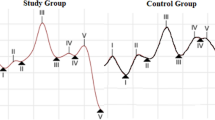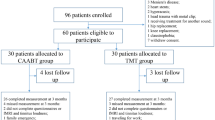Abstract
Purpose
We hypothesized that the cochlear–carotid interval (CCI), which is defined as the smallest distance along the petrous segment of the internal carotid artery and basal turn of cochlea, may be associated with direct stimulation of hair cells, thereby affecting tinnitus perception. The aim of this study was to investigate the relationships between the CCI, tinnitus perception, and accompanying hearing loss in patients with tinnitus.
Methods
The CCI on both sides was measured independently by two observers from the temporal 3D b-FFE MR images of 25 patients with tinnitus and 20 age/gender matched control subjects. The relationships between CCI, tinnitus visual analog scale (VAS), and tinnitus handicap inventory (THI) were investigated.
Results
CCI ranged 0.2–5.6 mm (1.9 ± 1.5) on the right and 0.1–5.4 mm (2.2 ± 1.6) on the left side in the patient group and 0.5–5.4 (1.9 ± 1.4) mm on the right and 0.3–6.7 (2.3 ± 1.7) on the left side in the control group. The differences between the two groups were not statistically significant (p > 0.05). CCI showed a strong negative correlation with THI and VAS scores on both sides. Correlation of audiologic findings with CCI revealed a significant negative correlation with pure tone average of the ipsilateral ear most affectedly at high frequencies.
Conclusion
The strong negative correlation of CCI with tinnitus-related distress and accompanying sensorineural hearing loss predominantly at high frequencies suggests that further studies on patients with tinnitus that focus on this small area may help to improve the knowledge of tinnitus pathophysiology.



Similar content being viewed by others
References
Cetin MA, Hatipoglu HG, Ikinciogullari A, Koseoglu S, Ozcan KM, Yuksel E, Dere H (2013) The importance of carotid–cochlear interval in the etiology of hearing loss. Indian J Otolaryngol Head Neck Surg 65(4):345–349
Dew L, Shelton C, Harnsberger H, Thompson BG Jr (1997) Surgical exposure of the petrous internal carotid artery: practical application for skull base surgery. Laryngoscope 107(7):967–976
Goycoolea M, Muchow D, Schirber C, Goycoolea HG, Schellhas K (1990) Anatomical perspective, approach and experience with multichannel intracochlear implantation. Laryngoscope 100(2 Pt 2 Suppl 50):1–18
Gunbey HP, Aydın H, Cetin H, Gunbey E, Karaoglanoglu M, Cay N, Alhan A (2011) MDCT assessment of the cochlear–carotid interval. Neuroradiol J 24(3):439–443
Heller AJ (2003) Classification and epidemiology of tinnitus. Otolaryngol Clin N Am 36:239–248
Landis JR, Koch GG (1977) The measurement of observer agreement for categorical data. Biometrics 33:159–174
Leonetti J, Smith P, Linthicum F (1990) The petrous carotid artery: anatomic relationships in skull base surgery. Otolaryngol Head Neck Surg 102(1):3–12
Lund AD, Palacios SD (2011) Carotid artery–cochlear dehiscence: a review. Laryngoscope 121(12):2658–2660
Modugno GC, Brandolini C, Cappello I, Pirodda A (2004) Bilateral dehiscence of the bony cochlear basal turn. Arch Otolaryngol Head Neck Surg 130(12):1427–1429
Muren C, Wadin K, Wilbrand H (1990) The cochlea and the carotid canal. Acta Radiol 31(1):33–35
Newman CW, Jacobson GP, Spitzer JB (1996) Development of the tinnitus handicap inventory. Arch Otolaryngol Head Neck Surg 122(2):143–148
Paullus W, Pait T, Rhoton A (1977) Microsurgical exposure of the petrous portion of the carotid artery. J Neurosurg 47:713–726
Shrout PE, Fleiss JL (1979) Intraclass correlations: uses in assessing rater reliability. Psychol Bull 86:420–428
Young RJ, Shatzkes DR, Babb JS, Lalwani AK (2006) The cochlear–carotid interval: anatomic variation and potential clinical implications. AJNR Am J Neuroradiol 27(7):1486–1490
Author information
Authors and Affiliations
Corresponding author
Ethics declarations
Conflict of interest
The authors have no conflict of interest concerning the materials or methods in this study or the findings specified in this paper.
Rights and permissions
About this article
Cite this article
Gunbey, H.P., Gunbey, E., Sayit, A.T. et al. The impact of the cochlear–carotid interval on tinnitus perception. Surg Radiol Anat 38, 551–556 (2016). https://doi.org/10.1007/s00276-015-1607-4
Received:
Accepted:
Published:
Issue Date:
DOI: https://doi.org/10.1007/s00276-015-1607-4




